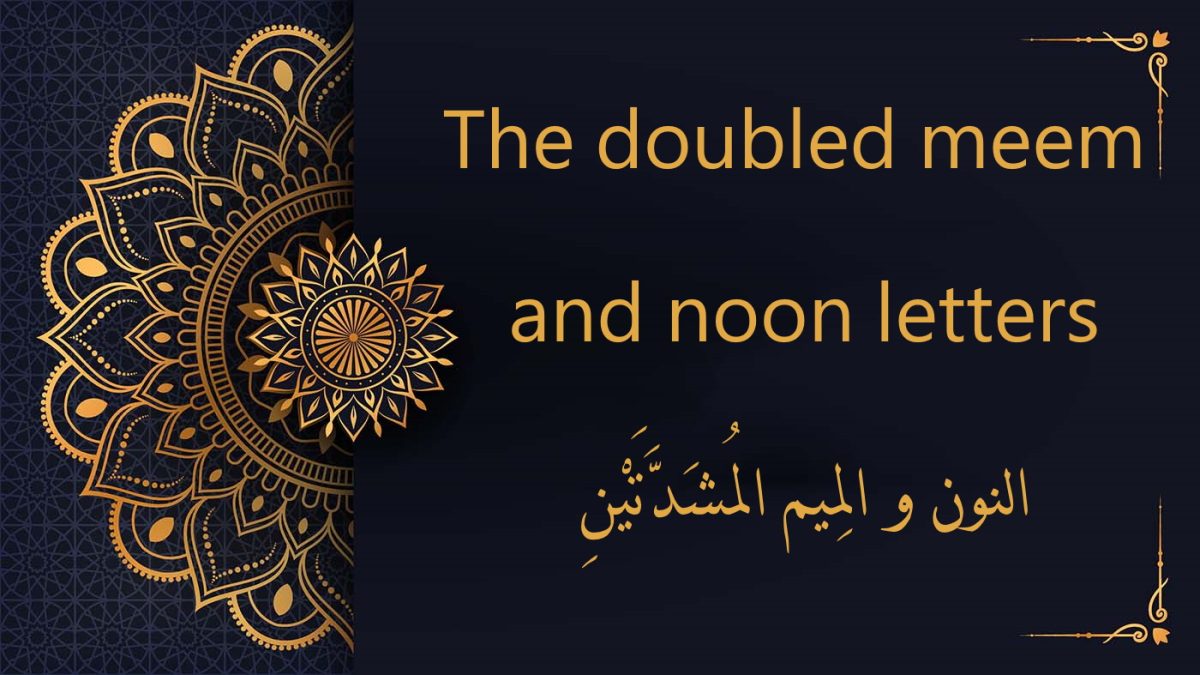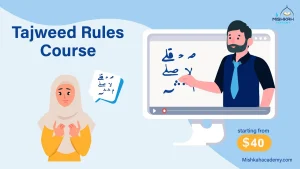Noon And Meem Mushaddad
Table of Contents
ToggleOne of the main benefits of learning the Qur’an with Tajweed is mentioned in the hadith of the Prophet “Those who can recite the Qur’an accurately and precisely will attain the highest ranks in Heaven” because the Holy Qur’an is the only book that its recitation is considered a form of worship with great reward. No other book or letter fits this description.
It is expected of every Muslim to read the Qur’an correctly as much as he can and in the correct way that was revealed to our Holy Prophet. Moving on to the article, we will study all the rules of Mim Sakina to the best of our ability.
Allah The Almighty said:
“And recite the Qur’an with a chant”, i.e., do not rush to read the Qur’an, but rather read it slowly and clearly while reflecting on the meanings.
Messenger of Allah (PBUH) said:
“The one who is proficient with the Qur’an will be with the noble and righteous scribes (the angels), and the one who reads it and stumbles over it, finding it difficult, will have two rewards.”
Ibn Al-Jazari also “Most Famous Tajweed Scholar” said:
“The practical application of Tajweed is without doubt compulsory. Who does not read the Quran correctly is a sinner”.
Before we shed light on Noon And Meem Mushaddad and dive into the practice comprehension of its rules, it is also recommended to read the Great Benefits Of Learning Tajweed Quran, as they are also very important an crucial.
We also need to explain why these conditions are known and applied while reciting the Holy Quran. As we know, reading the Qur’an well means reading it correctly according to the rules of Tajweed.
God Almighty revealed the Noble Qur’an to our Prophet Muhammad in this form (Tajweed) and commanded him to recite its verses, meditate on their meanings, understand their meanings, and beautify their recitation to be different and distinct from other textual readings.
Hence, putting How To Learn Tajweed Rules, including Noon And Meem Mushaddad, a priority and giving it its dues effort and time is of great importance. Also, understanding our responsibilities so that we can receive his mercy is of our greatest duties.
Before we clarify the Rules Of Noon And Meem Mushaddad, check this inspiring article to know How To Learn Tajweed Quran and apply its rules when reciting the Holy Quran.
Join thousands of Muslim Families who love learning Quran, Arabic and Islamic Studies from the comfort of their Homes.
Learn Quran, Arabic & Islamic Online
Meem And Noon Mushaddad

قَالَ سَنَشُدُّ عَضُدَكَ بِأَخِيكَ
Qaala sanashuddu ‘adudaka bi akheeka
Allah said: “We will strengthen your arm through your brother..”
In Arabic, there are diacritics including the “fat-ha – dhammah – kasrah” that can be the reason a word’s meaning changes completely. One of these diacritics is the shaddah. Insha’Allah We will explain what this is and move on to the rule of Noon and Meem Mushaddad.
Shaddah meaning is “[sign of] emphasis”. In general, is to make something tight. But how? It stresses a letter by doubling the sound. As given in other related posts [see “Noon Saakinah], a shaddah consists of two letters [doubling]:
Shaddah Explanation
The mechanism of pronouncing this Meem mushadadah:
• Closing the lips together and keeping it closed making the Ghunnah (nasalization) from nose.
• Keeping the tongue in its articulation point and making ghunnah for two counts.
• Whenever the letters noon or meem have shaddah sign, they are pronounced with ghunnah for 2 seconds.
Mushaddad Letter
The first letter is sakin, has sukoon sign on it while the second one has a respective diacritic, fat-ha, dammah, or kasrah.
فَوَيْلٌ لِلَّذِينَ
fawaylun lillatheena
Here we noted that the first shaddah on laam was there for notice purposes, and the second was there to be a shaddah and double that second laam. So is read as:
lil-latheena as written above, lillatheena
A few more examples of shaddah as follow:
كَرَّةً فَنَتَبَرَّأَ
kar–ratan fanatabar–ra‘a
karratan fanatabarra’a
وَالْمُطَلَّقَاتُ يَتَرَبَّصْنَ
wal mutal–laqaatu yatarab–basna
wal mutallaqaatu yatarabbasna
وَبُعُولَتُهُنَّ أَحَقُّ بِرَدِّهِنَّ
bu‘ulatuhun–na ahaq–qu birad-dihin-na
bu‘ulatuhunna ahaqqu biraddihinna
After we made shaddah clear, Tajweed rule regarding shaddah is as follows. For every noon and meem have a shaddah, one must sound a ghunnah.
Ghunnah is a sound made by nose from nasal passage. It is almost like a hum. Ghunnah is translated to “nasalisation” and this should not be longer than 2 seconds.
Noon Mushaddad Rules
إِنَّ أَنَّ منَّا إنَّك إِنَّا إِنَّما
Meem Mushaddad Rules
إِمَّا وإِمَّا أمَّن فأَمَّا فإِمَّا
And it is as simple as that! This Tajweed rule is complete! Where you see a shaddah on a meem or noon, just make ghunnah. As for Tajweed, just remember shaddah + meem or noon = ghunnah.
Noon And Meem Mushaddad Examples

Note:
if the reader stops on a word ending with Noon or Meem Mushaddad, the Gunnah for the Meem or Noon Mushadad still have to be applied.
Conclusion
We hope we have given you the opportunity to increase and improve your knowledge of Tajweed. In case you have any questions, feel free to contact us and ask for further clarification. Also, it is a great opportunity to enroll in the Holy Quran Course with Tajweed given by highly qualified teachers!
Mishkah Academy offers an online Tajweed program supervised by certified Quran and Tajweed teachers with Ijaza to teach Tajweed with several readings, the most important of which is Hafs on the authority of Assim.


























